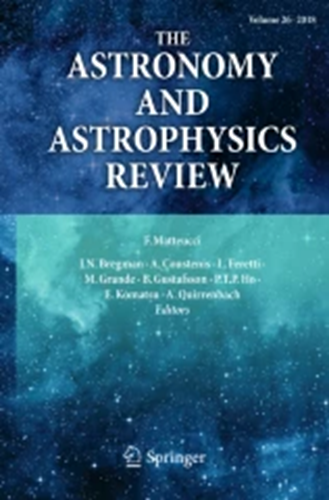Stellar collisions in flattened and rotating Population III star clusters
IF 27.8
1区 物理与天体物理
Q1 ASTRONOMY & ASTROPHYSICS
引用次数: 3
Abstract
Fragmentation often occurs in disk-like structures, both in the early Universe and in the context of present-day star formation. Supermassive black holes (SMBHs) are astrophysical objects whose origin is not well understood; they weigh millions of solar masses and reside in the centers of galaxies. An important formation scenario for SMBHs is based on collisions and mergers of stars in a massive cluster with a high stellar density, in which the most massive star moves to the center of the cluster due to dynamical friction. This increases the rate of collisions and mergers since massive stars have larger collisional cross sections. This can lead to a runaway growth of a very massive star which may collapse to become an intermediate-mass black hole. Here we investigate the dynamical evolution of Miyamoto-Nagai models that allow us to describe dense stellar clusters, including flattening and different degrees of rotation. We find that the collisions in these clusters depend mostly on the number of stars and the initial stellar radii for a given radial size of the cluster. By comparison, rotation seems to affect the collision rate by at most 20%. For flatness, we compared spherical models with systems that have a scale height of about 10% of their radial extent, in this case finding a change in the collision rate of less than 25%. Overall, we conclude that the parameters only have a minor effect on the number of collisions. Our results also suggest that rotation helps to retain more stars in the system, reducing the number of escapers by a factor of 2− 3 depending on the model and the specific realization. After two million years, a typical lifetime of a very massive star, we find that about 630 collisions occur in a typical models with N = 104, R = 100 R and a half-mass radius of 0.1 pc, leading to a mass of about 6.3 × 103 M for the most massive object. We note that our simulations do not include mass loss during mergers or due to stellar winds. On the other hand, the growth of the most massive object may subsequently continue, depending on the lifetime of the most massive object.扁平旋转星族III星团中的恒星碰撞
碎裂经常发生在盘状结构中,无论是在早期的宇宙中还是在今天的恒星形成过程中。超大质量黑洞(SMBHs)是一种起源尚不清楚的天体物理物体;它们的质量是太阳的数百万倍,位于星系的中心。SMBHs的一个重要形成场景是基于高恒星密度的大质量星团中恒星的碰撞和合并,其中最大的恒星由于动态摩擦而移动到星团的中心。这增加了碰撞和合并的速度,因为大质量恒星的碰撞截面更大。这可能会导致一颗非常大的恒星失控地生长,这颗恒星可能会坍缩成一个中等质量的黑洞。在这里,我们研究宫本永井模型的动态演化,使我们能够描述密集的星团,包括平坦和不同程度的旋转。我们发现,这些星团中的碰撞主要取决于恒星的数量和给定星团径向大小的初始恒星半径。相比之下,旋转似乎对碰撞率的影响最多为20%。对于平面度,我们将球形模型与尺度高度约为其径向范围10%的系统进行了比较,在这种情况下,发现碰撞率的变化小于25%。总的来说,我们得出结论,这些参数对碰撞次数的影响很小。我们的研究结果还表明,旋转有助于在系统中保留更多的恒星,根据模型和具体实现,将逃逸器的数量减少2 - 3倍。经过200万年,一个非常大质量恒星的典型寿命,我们发现在N = 104, R = 100 R,半质量半径为0.1 pc的典型模型中发生了大约630次碰撞,导致最大质量物体的质量约为6.3 × 103 M。我们注意到,我们的模拟不包括合并期间或由于恒星风造成的质量损失。另一方面,质量最大的物体可能随后继续增长,这取决于质量最大的物体的寿命。
本文章由计算机程序翻译,如有差异,请以英文原文为准。
求助全文
约1分钟内获得全文
求助全文
来源期刊

The Astronomy and Astrophysics Review
地学天文-天文与天体物理
CiteScore
45.00
自引率
0.80%
发文量
7
期刊介绍:
The Astronomy and Astrophysics Review is a journal that covers all areas of astronomy and astrophysics. It includes subjects related to other fields such as laboratory or particle physics, cosmic ray physics, studies in the solar system, astrobiology, instrumentation, and computational and statistical methods with specific astronomical applications. The frequency of review articles depends on the level of activity in different areas. The journal focuses on publishing review articles that are scientifically rigorous and easily comprehensible. These articles serve as a valuable resource for scientists, students, researchers, and lecturers who want to explore new or unfamiliar fields. The journal is abstracted and indexed in various databases including the Astrophysics Data System (ADS), BFI List, CNKI, CNPIEC, Current Contents/Physical, Chemical and Earth Sciences, Dimensions, EBSCO Academic Search, EI Compendex, Japanese Science and Technology, and more.
 求助内容:
求助内容: 应助结果提醒方式:
应助结果提醒方式:


